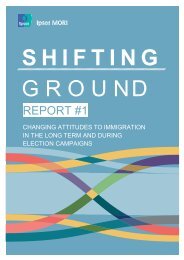Create successful ePaper yourself
Turn your PDF publications into a flip-book with our unique Google optimized e-Paper software.
so at a suitable opportunity [...and] when we say <strong>that</strong> Mahommedan opinion in<br />
general is on our side, we are talking of a very powerful asset indeed’. 228<br />
Muslims were motivated to back the British war effort for many of the same<br />
reasons as motivated them in the First World War. They included the fact <strong>that</strong><br />
Britain ruled over more Muslims than any other worldly power. Indeed, almost<br />
half of the world’s Muslims lived under British rule or in countries <strong>that</strong> enjoyed<br />
exceptionally close <strong>ties</strong> with the Empire. 229<br />
Not only <strong>that</strong>, but Britain safeguarded their rights better than any other power.<br />
By contrast, Italian control of East Africa (comprising parts of modern day<br />
Ethiopia, Eritrea, and Somalia) was characterised by instability, violence and<br />
chronic under-investment. Nor were stories about German officials brutally<br />
crushing Herero rebellions in modern South-West Africa or the Maji Maji in east<br />
Africa forgotten. 230<br />
Yet Muslim support could not sustain the war effort alone. The Indian Army<br />
needed men – so many <strong>that</strong> by 1945 an aggregate of just over 2.5 million recruits<br />
had served, creating the largest volunteer army in history. 231 Once again, the Army<br />
was forced to abandon its traditional ‘martial races’ approach to recruitment and<br />
offered to enlist any and all capable men. A written commentary produced by HM<br />
Stationery Office about ‘India at War’ noted <strong>that</strong> ‘provinces, areas and peoples who<br />
have hitherto been represented sparsely or not at all’ now found a place in the<br />
armed forces. For many, it was their first contact with the Raj. 232 A report on India’s<br />
Modern Army produced in 1945 found <strong>that</strong> ‘men who have never seen a motor car<br />
have to be turned into mechanics. The bulk of recruits have to be taught to read and<br />
write. Many even have to learn to wear a pair of boots’. 233<br />
The relaxing of rules relating to recruitment meant <strong>that</strong> volunteers now came<br />
through at an average rate of about 50,000 per month. Although some have<br />
dismissed these Indian soldiers as mercenaries, it is worth noting <strong>that</strong> the basic<br />
pay of an infantryman was no higher than <strong>that</strong> received by most unskilled<br />
workers. Indeed, when the threat of Japanese invasion looked most acute in 1942,<br />
after the fall of Rangoon during the Burma Campaign, enlistments reached their<br />
peak. A newspaper article suggested this was ‘proof enough <strong>that</strong> a great many<br />
Indians recognize their stake in this war’. 234<br />
Broadening the base of potential applicants in this way meant <strong>that</strong> the quality of<br />
those applying for commissioned ranks increased. 63 percent of aspirants were<br />
accepted, compared to just 46 percent before. To cope with extraordinary pressures<br />
being applied on the Indian Army there was also a need to create a fast-track for<br />
officer training, with more than 1000 being trained per annum by 1942. 235 In 1939<br />
there were only 307 Indian commissioned officers, rising to <strong>11</strong>,000 by 1945.<br />
Before the war, the proportion of British to Indian officers was 5.5 to 1.<br />
Recruitment of emergency commissioned officers meant <strong>that</strong> by 1945 the<br />
proportion was 1.5 British to 1 Indian. 236 By the end of May 1945 there were also<br />
three Indian Officers from combat units who had reached the rank of Brigadier, and<br />
a further 220 who were either Colonels or Lieutenant-Colonels. 237<br />
Indian officers in the Army fell into two classes – the Indian Commissioned<br />
Officer (ICO) and the Viceroy’s Commissioned Officer (VCO). The ICO was<br />
essentially the same as his British counterpart, exercising the same authority<br />
including, for example, command of British personnel who were attached to<br />
some of the technical units of the Indian Army. The VCO had no counterpart in<br />
Muslims in the World Wars<br />
228 Ibid.<br />
229 Ibid.<br />
230 Jan-Bart Gewald, Herero<br />
heroes: a socio-political history of<br />
the Herero of Namibia, 1890-1923<br />
(Oxford, 1998); J. D. Fage, A. D.<br />
Roberts, Roland Anthony Oliver,<br />
The Cambridge History of Africa:<br />
From 1905 to 1940 (Cambridge,<br />
1986).<br />
231 Military – Indian Army,<br />
L/I/1/1035, file No. 462/80E,<br />
pp.70-72, IOR, BL, London<br />
232 European war, booklet – India<br />
at War, 1941, L/I/1/903 file no.<br />
462/46, IOR, BL, London<br />
233 Military – Indian Army,<br />
L/I/1/1035, file No. 462/80E,<br />
pp.70-72, IOR, BL, London<br />
234 Ibid.<br />
235 India at War, 1941, L/i/1/903<br />
file no. 462/46, IOR, BL, London.<br />
236 Military – Indian Army,<br />
L/I/1/1035 file No. 462/80E,<br />
pp.147-9, IOR, BL, London<br />
237 Ibid, p.26<br />
policyexchange.org.uk | 53



